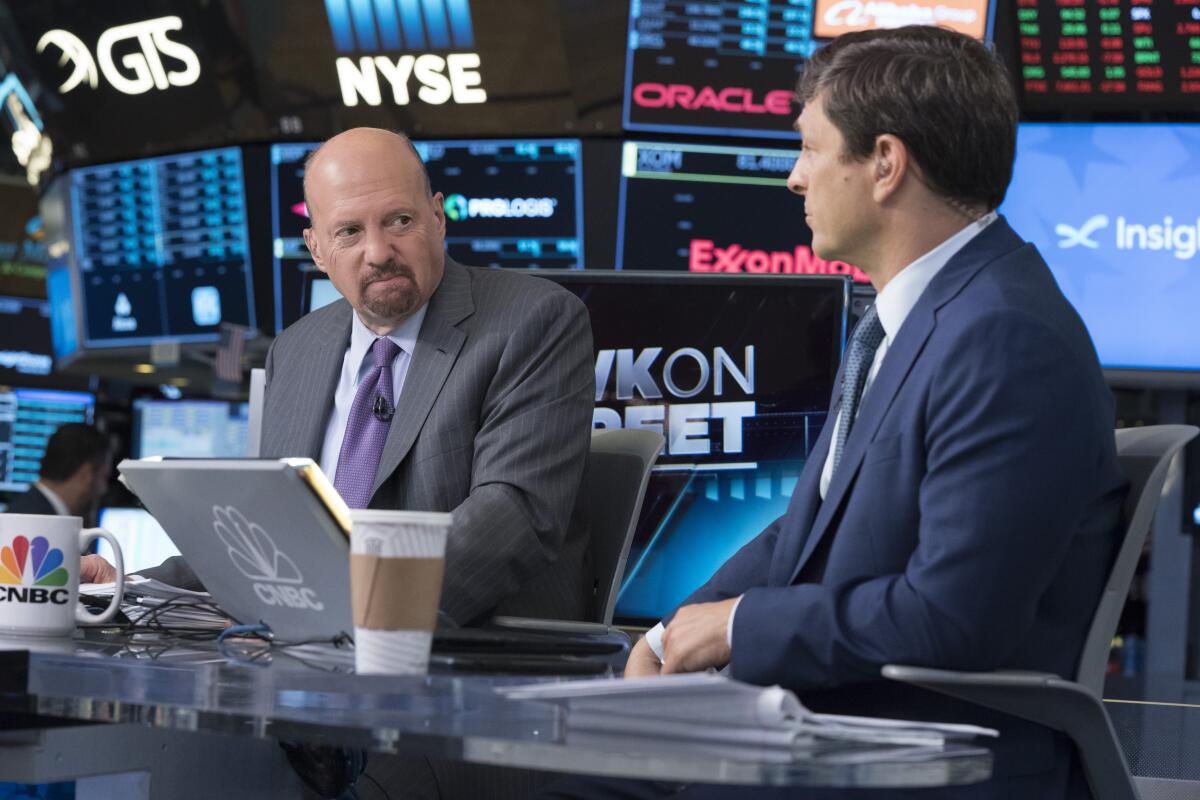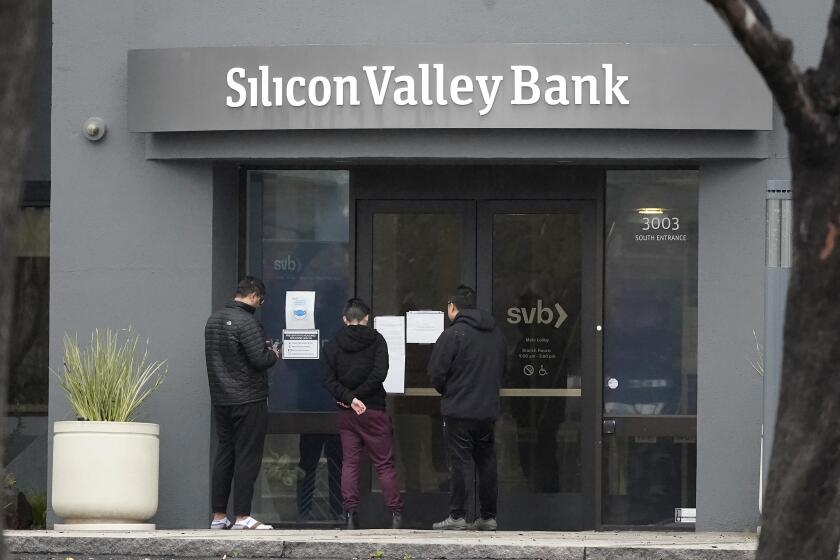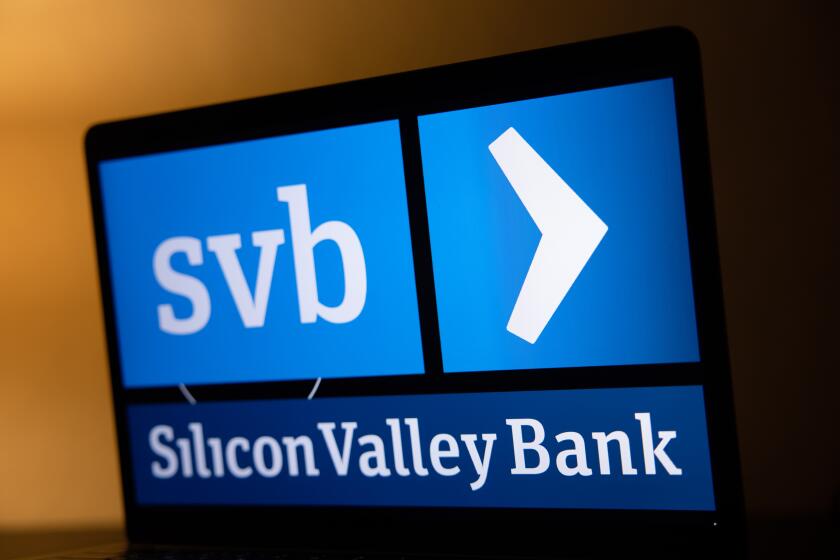Column: As Silicon Valley Bank’s red flags were flying, the Fed was AWOL

- Share via
On Jan. 18, William C. Martin, a short-seller and former hedge fund executive, warned his Twitter followers that they were missing something important about Silicon Valley Bank.
SVB’s shares had lost about 65% of their value over the previous 12 months. Investors had been “rightly fixated” on the bank’s exposure to the venture world, which was getting hammered by the rapid run-up in interest rates, he wrote.
“However, dig just a little deeper, and you will find a much bigger set of problems,” he wrote.
Apparently, the Fed was AWOL.
— Dennis Kelleher, Better Markets
What Martin had spotted was a plunge in the value of securities in the bank’s portfolio of “held to maturity” securities — Treasury bonds and government-backed mortgage securities that it owned as a backstop to its deposits.
Because the bank had no intention of selling the so-called HTM securities before they matured, it was permitted to value them on its books at the price at which they had been purchased, rather than at their values in real time.
Get the latest from Michael Hiltzik
Commentary on economics and more from a Pulitzer Prize winner.
You may occasionally receive promotional content from the Los Angeles Times.
But the value of the HTM holdings had declined as interest rates rose. That’s a natural phenomenon: Fixed-income securities always decline in value as rates rise, and rise in value when rates fall.
If the bank were forced to sell off those holdings before maturity, Martin observed, it would be “functionally underwater.”
SVB hadn’t kept this issue a secret. In its financial disclosure for the third quarter that ended Sept. 30, 2022, which was Martin’s source, it reported that its $93.3-billion held-to-maturity portfolio was worth only $77.4 billion in real time, for implicit losses of $15.9 billion. That was well more than the bank’s $11.5 billion in total equity.
The bank’s position didn’t much improve in the fourth quarter. It reported then that its HTM portfolio had shrunk slightly, but was still showing unrealized losses of $15.16 billion. According to accounting rules, other securities designated as “available for sale” have to be carried at their real-time value, a process known as “marking to market.”
The fact that SVB’s problems were hiding in plain sight, right up to the point Friday when the bank was taken over and shut down by California and federal authorities, is certain to be near the top of the agenda as lawmakers, shareholders, customers and regulators examine the disaster.
Demands by the tech industry’s most vocal libertarians for a government bailout of Silicon Valley call to mind the old saw: The goal in business to privatize profits and socialize losses.
As the bank’s primary regulator, it was the Federal Reserve’s responsibility to recognize its growing problems and ensure it continued to meet standards of safety and soundness and financial stability, says Dennis Kelleher, chief executive of Better Markets, a Washington-based watchdog over financial institutions and government regulators.
The bank’s operations bristled with “screaming red flags,” Kelleher told me. These included a “hyperconcentration” of uninsured depositors from a narrow business sector — chiefly high-tech and biotech startups — as well as a dramatic mismatch between assets (that is, loans and investments) and liabilities (deposits) and the mounting tide of unrealized losses on its books.
“These were visible to anyone who wanted to look,” Kelleher told me. “But apparently, the Fed was AWOL.”
The Silicon Valley Bank failure is the old story of what happens when short-term depositors want their money back from a bank with only long-term assets.
Kelleher observes that the Fed’s policy of pegging interest rates near zero during the pandemic “was causing bubbles all over the place and reckless lending.”
The Fed staged an unprecedented about-face on interest rates starting in March 2022 — raising rates by 4.5 percentage points in the space of nine months. “Banks were not going to be able to reposition their portfolios anywhere near as quickly as the Fed is changing policy.”
That behooved the Fed to take a close look at all the banks. Kelleher says that Fed examiners should have demanded a plan last year from SVB’s management or board for unwinding its large and growing impairment. It did not do so.
Another red flag for regulators should have been the bank’s rapid growth, which almost certainly placed pressure on management skills in the corporate suite.
Deposits soared from $49.3 billion at the end of 2018 to $189.2 billion at the end of 2021, before falling back slightly to $173.1 billion at the end of last year.
The drawdown was a clue that the venture-funded sector had slowed down — venture firms were being less freewheeling with their money amid the run-up in interest rates, which also created business head winds for their portfolio companies, which in turn needed to draw down their deposit balances.
During the same period, the bank’s asset holdings rose from $71 billion in 2018 to $211.8 billion at the end of last year. The vast majority of its fixed-rate assets, plainly, had been purchased when rates were close to zero and therefore were vulnerable to plunges in value as rates rose.
The Wall Street Journal says America ‘soaks the affluent.’ Try to hold back your tears.
As much as two-thirds of those holdings were in the held-to-maturity portfolio, however, so they were carried on the bank’s balance sheet at their purchase price, not the real value.
It’s true that bank regulations applying to institutions the size of SVB were liberalized in 2018 by President Trump — in part due to lobbying by SVB itself, among others. But that didn’t absolve the Fed of the obligation to scrutinize the bank’s operations, Kelleher says.
The Fed wasn’t the only entity that allowed the scale of SVB’s problems to go unremarked. Questions are sure to be raised about the performance of the bank’s auditing firm, KPMG. The firm issued a clean bill of health for the bank, known as an “unqualified” opinion, with the bank’s annual report, released on Feb. 24.
KPMG hinted that it was concerned about the bank’s method for projecting credit losses on some of its loans, but didn’t rule them as improper. Instead, it designated the method a “critical audit matter,” which typically refers to issues that are “especially challenging, subjective, or complex” but don’t warrant a warning about a company’s prospects for failure.
It’s true that the crash in the bank’s fortunes developed after Dec. 31, the endpoint of KPMG’s audit. But the firm could have been more explicit about the perils lurking in the bank’s financial structure.
Also deserving scrutiny is the role of venture investment firms and their portfolio companies. Many venture firms encouraged the startup companies they nurtured to do their banking business with SVB.
Indeed, having a financial relationship with SVB was treated as almost a badge of honor for a startup, a signal that it genuinely had business potential. The terms of loans that SVB made to startups often required that the borrowers do all their banking with SVB, a mandate that concentrated the bank’s depositor base while exposing the startups to risks related to the FDIC’s $250,000 cap on its deposit insurance protection. Some depositors kept uninsured cash balances in the hundreds of millions of dollars at SBV, an obviously reckless practice.
The complacency about SVB’s condition as its problems accelerated is illustrated by its popularity among Wall Street stock pickers—its shares were rated “buy “ by investment analysts at JP Morgan, Bank of America Securities, Jefferies and Goldman Sachs, among others, as recently as days before its collapse.
On Feb. 8, stock market guru Jim Cramer, whose daily CNBC program is widely followed by amateur stock traders, named shares of SVB Financial, the bank’s parent company, as one of his “10 top performers” for 2023.
Cramer called SVB a “merchant bank with a deposit base that Wall Street is mistakenly concerned about.” He argued that “long-term private equity and venture capital ... are not going away, and being a banker to these immense pools of capital has always been a very good business.”
As it happens, Cramer’s stock picks have had such an uneven record that one investment firm recently brought out an exchange-traded fund that allows investors to take the opposite side of Cramer’s picks.
Anyone who disdained the recommendations of Cramer and the other enthusiastic analysts on SVB and shorted the stock rather than buying would have made a healthy profit. The shares closed at $106.04 on Thursday, and the next day were effectively worth zero.
More to Read
Get the latest from Michael Hiltzik
Commentary on economics and more from a Pulitzer Prize winner.
You may occasionally receive promotional content from the Los Angeles Times.














